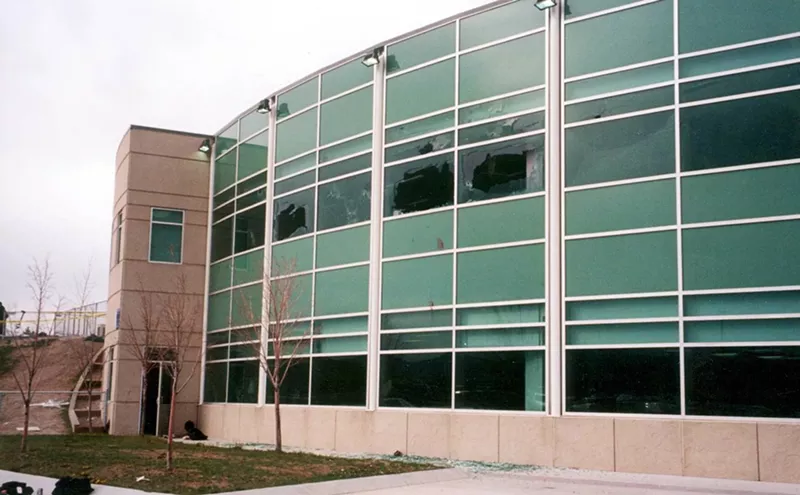"There are wonderful people who believe the Mother of God has appeared," says Patrick O'Brien, a meat-cutter--and faithful Catholic--who was mad enough about Dragicevic's arrival to fire off an angry letter to the Denver Catholic Register. "I don't believe any of them. The thing is an epidemic."
More and more Marian conferences are held in the United States each year. Between twenty and thirty such events will take place this year, says organizer Ed Langfield, who runs the Rocky Mountain Marian Center. The growing number of events is expected to lower attendance from the 10,000 people Langfield drew to Denver in 1992 to 4,500 at next month's event.
The conference will feature speakers, masses and healing sessions. Though two reverends from the Catholic Archdiocese of Denver are speaking, church officials are trying to maintain at least some distance from the controversial event. "We don't specifically approve any of the speakers," says Bill Beckman, the archdiocese's director of catechetics, the church's educational division. "But we do believe in the gathering itself. We're sure there will be a great deal of things entirely in keeping with Catholic tradition."
But critics contend that just having the Medjugorje speaker is not in keeping with Catholic tradition, since the Medjugorje vision has not been officially endorsed by the church. And there will be enough vendors peddling everything from books to Mary statues to rosaries that some wonder if attendees will spend most of their time praying to the almighty dollar.
Langfield says setting up a Marian conference has not been a profit-making venture. Although he estimates that the 1992 conference probably brought in $300,000, he says little was left over after paying for convention space and paying to fly in and house all the speakers. What money remained, he says, was donated to charity. This year, he estimates, he will need attendance of at least 3,500 to break even. And he says excess funds will be given to the speakers as stipends. Observers say that doesn't mean vendors and others don't make money off such conferences.
"There is the capacity for manipulation, but that's the U.S. of A.," says Michael Cuneo, a sociology professor at Fordham University who writes about Marian visions. "I think it does happen--yeah, definitely--but the people who are perpetrating the 'fraud' are not always totally conscious of it. I haven't seen any cases where there is a clear-cut case of fraud."
Cuneo says there is a ready audience eager for anyone hawking spiritual bromides. "People desperately look for this," he says. "If you go out and say the Virgin Mary just spoke to you and she'll speak to you again at 8 o'clock at Mile High Stadium, you'd get thousands of people to show up, and you'd be able to collect ten bucks a head."
Beckman and others concede there is a commercial appeal to the conferences, but they say it's not a major factor. "I think the main motivation is spiritual," says Beckman. "But if they decide they want to buy a book, it's good they were able to pick it up while they were there."
Sometimes attendees get more than they bargain for. Five years ago Highlands Ranch resident Theresa Lopez claimed to have seen the Virgin Mary at Mother Cabrini Shrine. Soon after, 6,000 pilgrims from around the country flocked to Colorado to catch a glimpse of the supernatural.
They apparently saw nothing but the sun, and too much of it at that--about two dozen people suffered eye damage from staring at it too long.
The Denver Archdiocese investigated and concluded there was no vision. Archbishop J. Francis Stafford wrote at the time, "I strongly advise and urge the Christian faithful not to participate in any future public gatherings associated with these private revelations." He went on to remind the faithful that out of 232 alleged apparitions in 32 countries between 1928 and 1976, only 6 were deemed authentic by the Roman Catholic Church. Medjugorje, a small village in what is now Bosnia-Herzegovina, has been wrapped in controversy since six children first claimed to have seen a vision of the Virgin Mary on a hilltop on June 25, 1981. Four of the six still claim to see Mary daily, and their tale has led millions of people to visit the shrine in search of spiritual rejuvenation. Americans began large-scale pilgrimages to the site in the mid-Eighties, and many reported seeing such phenomena as protective shields over the sun that allowed them to stare at it without hurting their eyes, rosaries changing colors, weeping statues, celestial music and, of course, Mary. When they returned to the States, they spread the faith by founding Marian centers across the country.
Although the visions at Medjugorje haven't received official support, they haven't been roundly condemned , either. Church officials have been careful not to come down too hard on what some members of their flock insist is the real thing--especially when it comes to sightings of Mary. Langfield says believers view Mary as an intermediary between them and God. Cuneo has his own explanation of the increase in Marian sightings and conferences: Catholics feel that Catholicism "no longer provides the promise of eternal salvation. It's lost its sense of supernatural drama."
So if the church and the Pope cannot provide these things, Cuneo says, people are looking for it on their own. "They want to believe in miracles. They want to believe God exists and is speaking to them," he says. "They don't get that from the institutional church."
Some Catholic observers are harsher in their criticism. E. Michael Jones, editor of an Indiana-based Catholic magazine called Fidelity, visited Medjugorje in 1988 and concluded that it's "as phony as a three-dollar bill. The kids lied repeatedly. They were notorious liars."
Church officials in Yugoslavia have not been too enthusiastic about the town, either. In 1986 the Bishop of Mostar--the Catholic jurisdiction in which Medjugorje is located--ended a five-year investigation with a report that said the town was not an authentic holy place. And in 1991 the Yugoslavian Council of Bishops ruled that "on the basis of investigations so far, it cannot be affirmed that one is dealing with supernatural apparitions and revelations."
But local organizer Langfield insists that the church has "not condemned it or taken any kind of action. They are quick to condemn it if they think it's a hoax." He contends that the Yugoslavian bishop was pressured to denounce Medjugorje by the Communist rulers of the day, who viewed the visions as a political threat. (And with good reason: Earlier visions in Fatima, Portugal, were generally interpreted as anti-Communist manifestos, one of the reasons the Medjugorje sightings were taken so seriously by the civil authorities there.)
Currently, the Catholic church does not ban pilgrimages to Medjugorje, though it does discourage church leaders from "officially sponsoring" trips. In Denver, Beckman says, the decision on whether to endorse the Medjugorje visions is "not within our province to judge. But from what I might gather, I don't have the sense it will be approved anytime soon."
The church, observers point out, is always cautious in such matters. It doesn't want to give the thumbs-up on Medjugorje or any other sightings only to have them turn out to be a hoax. For instance, it took the church thirteen years (from 1917 to 1930) to authenticate visions in Lourdes, France, after initial sightings of Mary were reported. Today, Lourdes is one of the most popular pilgrimage spots--as well as the inspiration for the name of pop star Madonna's new baby.
Often, pilgrims return from such visits with visions of their own, such as spreading the word. Langfield, who has been to Medjugorje ten times and found the experience "spiritually enlightening," doesn't mind naysayers who claim that pilgrims are misled. He says that many famous people have embraced the Medjugorje experience; as proof, he's quick to offer the phone number of entertainer Lola Falana, who is scheduled to attend the Denver conference. "If they have thoroughly investigated it and that's the consciousness they arrive at, that's fine," he says of critics. "The ones I object to are the ones that just say, 'I don't believe it,' and they've never checked it."
As more and more people insist they've seen the Virgin Mary, more individuals are cashing in. Jones and others says that shopkeepers in towns like Medjugorje and Lourdes aren't the only recipients of dollars from the faithful. They say that American pilgrims who have gone to such places are returning home to carve out a nice living from speaking at or hosting events like the upcoming Denver conference.
As Fidelity's Jones notes, "You don't make money by being anti-Medjugorje. You make money by going along with it.












